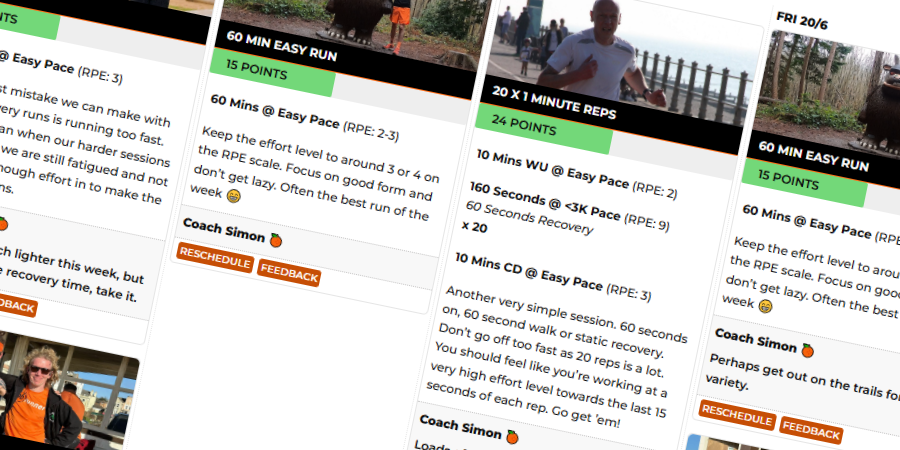What are training points I hear you ask?
All I’ve done is reword training load, to training points, to provide a more positive spin on it.
Every session I allocate to my runners, has a certain number of training points attached. The higher the training points, the more demanding the session and the more beneficial it will be to your fitness.
In the simplest term, Training Points = Time or Distance x RPE (Effort Level)/10. I added in the division of 10, as trying to accumulate 120 points a week sounds much more achievable than 1200. Plus it makes it easier from a coaching perspective when compiling training plans.
Here are some examples of sessions and the training points they accumulate.
60 mins Easy = 18 Training Points
20 x 1 Mins = 24 Training Points
120 Mins Long Run = 36 Training Points
10 x 1 km = 44 Training Points
A Marathon = 105 Training Points
Training Load sounds hard work. In the past I’ve looked at a session like 10 x 1km and thought “This is going to be horrible”. I want that mindset to change, so as runners we see a hard session as an opportunity to bank some big training points to contribute to our weekly targets.
So that’s why I want to use the terminology “Training Points”, rather than “Training Load”.
All the plans I create are done to “Training Points”. So before a runner joins my team or starts a new plan, I will look back at their recent training, to see how many points they have been averaging each week.
Then I will simply increase the average training points target, to ensure progression. So an example would be a runner who has just finished their first training plan and averaged 100 training points per week. For their next plan I would look to increase this to 105.
The ultimate challenge for me, as a running coach, is to find the correct Training Points target for every single one of my runners. If the target is too low, that runner won’t progress, too high and injury is likely to occur.
It’s also important that the sessions I do allocate are tailored to that runner and their goals.
How does this all relate to you as the runner?
Well imagine your current fitness is 80pts per week. That could be your limit. If that is true, if you accumulate 85 pts per week you should make progress, because you are pushing your body beyond it’s current level. As long as you get the right rest and recovery after a big session, your body will make those adaptations and you’ll get fitter, faster and stronger.
If you suddenly did 120 pts in a week, the likely outcome is an injury.
However if over the course of 10 weeks you fell short of that mark, 70 pts per week, the likelihood is, your fitness levels will regress slightly.
This is why it’s helpful as a runner, to have a good understanding of training points and how many you are accumulating. If it all sounds a little overwhelming, then you can leave that down to the coach, that’s my job after all.
But as a runner, if you miss a session or two, you now have a good understanding of how that impacts your progress.
Niggles and illness are inevitable, so it’s important not to go chasing missed points, as it will increase the risk of injury. So if you miss a week and 80 is your current fitness capacity, doing 160 the following week is clearly going to end badly.
What I’ve also learned more recently is the different number of ways we can accumulate training points. Going forward I will be including S&C as part of the weekly targets. Other methods of cross training include circuit classes, cycling, swimming and the elliptical. So there are lots of way we can hit our targets without simply running more.
When I first started writing my own training plans in 2018, my approach was simple, run more miles. This worked, to some degree. And in 2020 I was regularly running 50 miles a week. But with that came a lot of fatigue, niggles and obviously more time committed to running all those miles.
Over the last few years I’ve averaged closer to 30 miles a week and found new ways to get quicker. My training points target continues to rise, but I’m still only running 4 times per week.
Since first introducing this approach to create my plans, the results have been excellent and I’m hopeful I can continue to refine the process to help even more runners stay injury free and achieve your goals.








